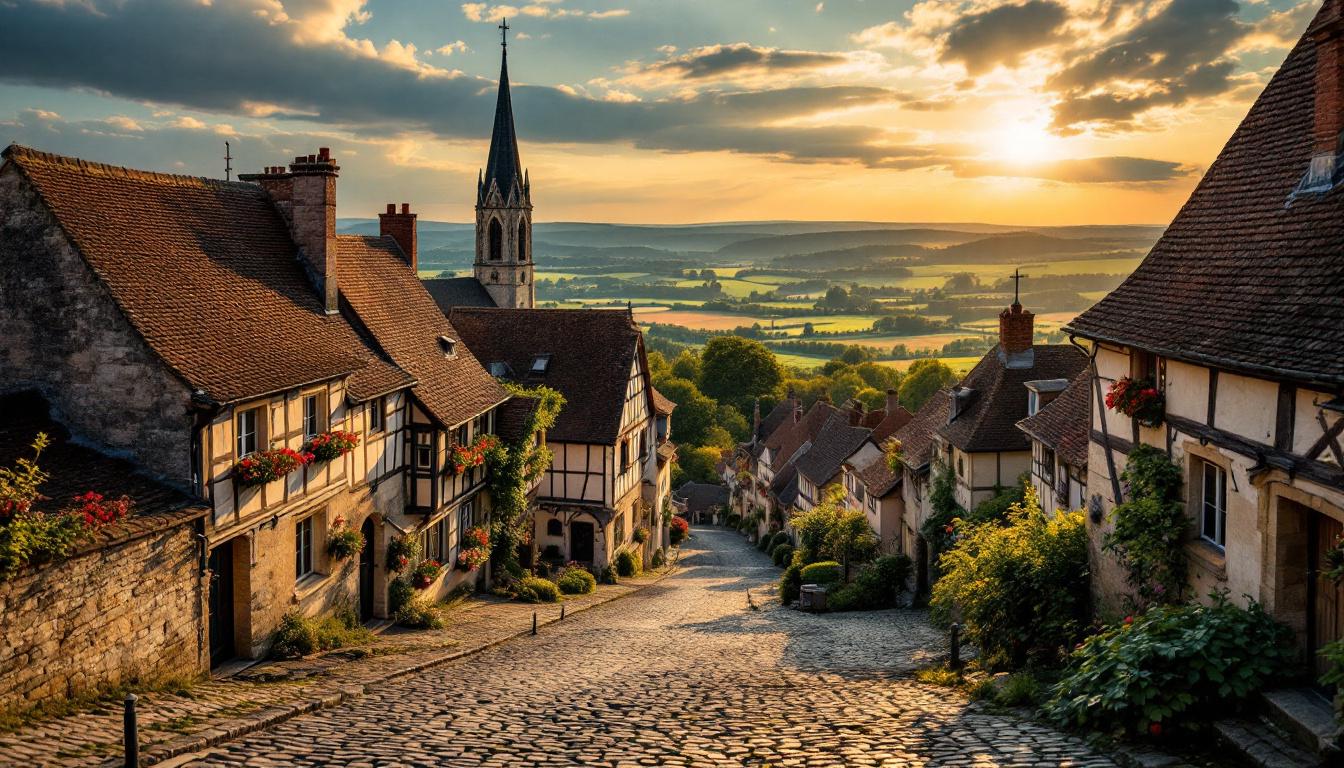Hidden behind rolling hills in Normandy’s Calvados region sits Beaumont-en-Auge, a village so perfectly preserved it feels like stepping into a living watercolor painting. With just 400 residents maintaining their medieval half-timbered houses against the backdrop of the sweeping Touques Valley, this hilltop haven represents authentic Normandy at its finest – without the tour buses that plague more famous destinations.
A panoramic throne above Normandy’s finest countryside
Perched at 90 meters elevation, Beaumont-en-Auge commands breathtaking views that stretch all the way to the English Channel on clear days. The village’s strategic position offers visitors a rare opportunity to witness the patchwork of apple orchards, pastures, and forests that define the iconic Pays d’Auge landscape.
“Our village may be small, but we stand tall in Normandy,” says Marie Duval, owner of the local bakery. “From our hilltop, you can see seven distinct hills – each with its own character, like children in a family.”
Where a mathematical genius was born between timber frames
Few visitors realize they’re walking the same cobblestone streets that nurtured one of history’s greatest mathematical minds. Pierre-Simon Laplace, whose work in celestial mechanics earned him the title “French Newton,” was born here in 1749. His modest birthplace at 4 Place de Verdun remains a pilgrimage site for science enthusiasts.
The 11th-century Saint-Sauveur Church, with its weathered stone walls and Gothic elements, stands as the village’s spiritual anchor and historic centerpiece. Its architecture reveals layers of history through distinct construction periods visible in the stonework.
The last kaleidoscope maker in Europe hides in plain sight
Among Beaumont’s greatest treasures is “Après la Pluie,” a tiny workshop where Dominic Stora creates Europe’s last handcrafted kaleidoscopes. Step inside this unassuming half-timbered building to witness generations of optical craftsmanship preserved through meticulous attention to detail.
“Each kaleidoscope captures something essential about how we see the world,” Stora explains while demonstrating his technique. “Just as medieval villages preserve ancient knowledge, I maintain this tradition one piece of glass at a time.”
Norman cuisine that honors the land and sea
Beaumont-en-Auge’s culinary scene punches far above its weight with three outstanding restaurants serving authentic Norman specialties. Le P’tit Beaumont, Le Café des Arts, and L’Auberge de l’Abbaye each showcase the region’s famed dairy, apple-based drinks, and fresh seafood from nearby coastal towns.
Don’t miss sampling Calvados apple brandy at Le Pré Verger, just minutes from the village center. Their distillery tours offer insights into traditional production methods that rival even the finest cognac production.
Escape the crowds of coastal Normandy
While tourists flock to Deauville and Honfleur just 15-25 minutes away, Beaumont-en-Auge remains blissfully authentic. The village offers the perfect balance – close enough to enjoy the beaches and seafood restaurants of the coast while retreating to peaceful evenings where locals still outnumber visitors.
Unlike more commercialized medieval destinations, Beaumont preserves its character through small details: flower boxes bursting with geraniums, ancient chestnut trees in the town square, and residents who greet each other by name.
When to experience Beaumont at its finest
Visit in August to experience “Les Petites Puces de Beaumont-en-Auge,” the village’s beloved annual garage sale where treasures await between stalls of local produce and handicrafts. September offers perfect weather for hiking the surrounding “7 hills” trail, with ideal conditions reminiscent of perfect bay weather.
While winter brings quiet contemplation to the village, spring reveals Beaumont’s most magical quality – panoramic views of apple blossoms blanketing the valley below, creating an atmosphere that rivals even the most famous sunset destinations.
Beaumont-en-Auge represents Normandy distilled to its essence – a place where timber-framed houses have withstood centuries, panoramic views inspire poets and mathematicians alike, and traditions of craftsmanship continue without fanfare. In a region famous for its D-Day beaches and Mont Saint-Michel, this hilltop haven offers something increasingly rare: an authentic Norman village where the pace of life still follows the seasons rather than the tour buses.
